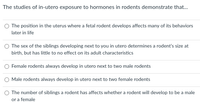
Human Anatomy & Physiology (11th Edition)
11th Edition
ISBN: 9780134580999
Author: Elaine N. Marieb, Katja N. Hoehn
Publisher: PEARSON
expand_more
expand_more
format_list_bulleted
Question
Please help me with these problems, I am very confused, there may be multiple answers or just one

Transcribed Image Text:### Nature vs. Nurture: Correcting Misconceptions
**Question:**
Which of the following statements corrects the misconception promoted by the 'nature vs. nurture' fallacy?
**Options:**
1. All behavioral traits, unlike other biological traits (such as fur color, for example), are determined by the interaction of genetic and environmental effects.
2. Every biological trait (and, as a consequence, every behavior) is determined by the interaction of genetic and environmental effects.
3. Behaviors do not have a genetic component to them, but all other biological traits do, to some extent.
4. Every biological trait (and, as a consequence, every behavior) is determined by either genetic OR environmental/developmental effects.
5. Almost all biological traits are determined by the interaction of genetic and environmental effects; behavioral traits are the exception.
**Explanation:**
The question aims to address and correct common misconceptions regarding the influence of genetics (nature) and environment (nurture) on biological and behavioral traits. The accurately corrected statement will reflect modern scientific understanding that most traits, including behaviors, are the result of interactions between genetic and environmental factors.
**Graph/Diagram Explanation:**
There are no graphs or diagrams accompanying this question.
The reader is encouraged to consider how each option reflects the interplay between genetics and environment, moving beyond the simplistic dichotomy of 'nature vs. nurture' toward a more integrated perspective.

Transcribed Image Text:### Understanding In-Utero Hormone Exposure in Rodents
**Research into In-Utero Hormone Exposure on Rodents:**
Scientific studies examining in-utero exposure to hormones in rodents have demonstrated several key findings. These research outcomes are essential for understanding developmental biology and the effects of prenatal environments on later life behaviors and characteristics. Consider the following statements that summarize these findings:
1. **Behavioral Effects Based on Uterine Position:**
- The position in the uterus where a fetal rodent develops affects many of its behaviors later in life.
2. **Sibling Sex Influence:**
- The sex of the siblings developing next to you in utero determines a rodent's size at birth but has little to no effect on its adult characteristics.
3. **Female and Male Rodent Development Patterns:**
- There is no consistent finding that female rodents always develop in utero next to two male rodents.
- Similarly, male rodents do not always develop in utero next to two female rodents.
4. **Sex Determination Based on Sibling Numbers:**
- The number of siblings a rodent has affects whether a rodent will develop to be a male or a female.
These points highlight the complex interplay between prenatal environments and postnatal outcomes in rodents. For further detailed data analysis and visual representation, researchers often rely on graphs and diagrams to illustrate hormonal influence and developmental variations among rodents in different uterine environments.
**Note:**
This summary is based on cumulative research and illustrates critical aspects of how fetal development conditions, particularly hormonal exposures and sibling dynamics in utero, shape various life outcomes in rodent populations.
Expert Solution
This question has been solved!
Explore an expertly crafted, step-by-step solution for a thorough understanding of key concepts.
Step by stepSolved in 3 steps

Knowledge Booster
Learn more about
Need a deep-dive on the concept behind this application? Look no further. Learn more about this topic, biology and related others by exploring similar questions and additional content below.Similar questions
arrow_back_ios
arrow_forward_ios
Recommended textbooks for you
 Human Anatomy & Physiology (11th Edition)BiologyISBN:9780134580999Author:Elaine N. Marieb, Katja N. HoehnPublisher:PEARSON
Human Anatomy & Physiology (11th Edition)BiologyISBN:9780134580999Author:Elaine N. Marieb, Katja N. HoehnPublisher:PEARSON Biology 2eBiologyISBN:9781947172517Author:Matthew Douglas, Jung Choi, Mary Ann ClarkPublisher:OpenStax
Biology 2eBiologyISBN:9781947172517Author:Matthew Douglas, Jung Choi, Mary Ann ClarkPublisher:OpenStax Anatomy & PhysiologyBiologyISBN:9781259398629Author:McKinley, Michael P., O'loughlin, Valerie Dean, Bidle, Theresa StouterPublisher:Mcgraw Hill Education,
Anatomy & PhysiologyBiologyISBN:9781259398629Author:McKinley, Michael P., O'loughlin, Valerie Dean, Bidle, Theresa StouterPublisher:Mcgraw Hill Education, Molecular Biology of the Cell (Sixth Edition)BiologyISBN:9780815344322Author:Bruce Alberts, Alexander D. Johnson, Julian Lewis, David Morgan, Martin Raff, Keith Roberts, Peter WalterPublisher:W. W. Norton & Company
Molecular Biology of the Cell (Sixth Edition)BiologyISBN:9780815344322Author:Bruce Alberts, Alexander D. Johnson, Julian Lewis, David Morgan, Martin Raff, Keith Roberts, Peter WalterPublisher:W. W. Norton & Company Laboratory Manual For Human Anatomy & PhysiologyBiologyISBN:9781260159363Author:Martin, Terry R., Prentice-craver, CynthiaPublisher:McGraw-Hill Publishing Co.
Laboratory Manual For Human Anatomy & PhysiologyBiologyISBN:9781260159363Author:Martin, Terry R., Prentice-craver, CynthiaPublisher:McGraw-Hill Publishing Co. Inquiry Into Life (16th Edition)BiologyISBN:9781260231700Author:Sylvia S. Mader, Michael WindelspechtPublisher:McGraw Hill Education
Inquiry Into Life (16th Edition)BiologyISBN:9781260231700Author:Sylvia S. Mader, Michael WindelspechtPublisher:McGraw Hill Education

Human Anatomy & Physiology (11th Edition)
Biology
ISBN:9780134580999
Author:Elaine N. Marieb, Katja N. Hoehn
Publisher:PEARSON

Biology 2e
Biology
ISBN:9781947172517
Author:Matthew Douglas, Jung Choi, Mary Ann Clark
Publisher:OpenStax

Anatomy & Physiology
Biology
ISBN:9781259398629
Author:McKinley, Michael P., O'loughlin, Valerie Dean, Bidle, Theresa Stouter
Publisher:Mcgraw Hill Education,

Molecular Biology of the Cell (Sixth Edition)
Biology
ISBN:9780815344322
Author:Bruce Alberts, Alexander D. Johnson, Julian Lewis, David Morgan, Martin Raff, Keith Roberts, Peter Walter
Publisher:W. W. Norton & Company

Laboratory Manual For Human Anatomy & Physiology
Biology
ISBN:9781260159363
Author:Martin, Terry R., Prentice-craver, Cynthia
Publisher:McGraw-Hill Publishing Co.

Inquiry Into Life (16th Edition)
Biology
ISBN:9781260231700
Author:Sylvia S. Mader, Michael Windelspecht
Publisher:McGraw Hill Education